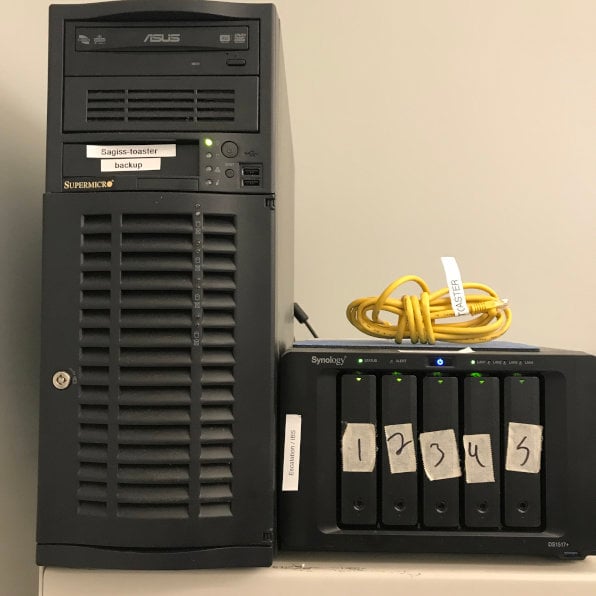5 min read
Data backup and disaster recovery [Updated]
Published: March 29, 2022 Updated: April 10, 2024
![Data backup and disaster recovery [Updated]](https://www.sagiss.com/hubfs/Media/Blog/data-backup-disaster-recovery.webp)
People often use the terms "data backup" and "disaster recovery" as if they are synonyms. While the two concepts are fundamental parts of business continuity planning, they are not the same thing.
The purpose of data backup is to keep recent copies of essential data in case the original copy is lost.
Disaster recovery, on the other hand, is focused on rebooting the mission-critical systems that keep your business running from one moment to the next.
Data backup and disaster recovery are separate services, but they are often lumped together. In this post, we will explain where data backup and disaster recovery overlap and where they differ.

What is data backup?
Data backup entails creating a digital archive of your data and files.
Most people have likely performed their own data backups by copying data and files from their personal computers to an external USB hard drive. Maybe they've performed this backup in preparation for migrating to a new computer. Or maybe they did it to give peace of mind in case their primary hard drive fails.
While this simple backup method might be enough for individuals, business backup solutions tend to be a bit more complicated. So businesses may need more consideration when determining the right types of data storage for the job. No matter which tools a business uses for the job, the fundamental concepts are the same.
Local backup and online backup
Copies of backup data should be stored in multiple locations. A good backup solution also includes both a local component and an offsite component generally referred to as a hybrid backup system. One copy of data is kept onsite at the business headquarters, while another is stored in an offsite cloud server. If the main office were to flood or catch fire, another copy of the data exists safely offsite. Meanwhile, the onsite copy allows for quick restoration in the event of a minor loss of data.
Large cloud services like Microsoft Azure offer a service called geographic redundancy. This means they can store copies of a business’s information in several datacenters at once. Should a natural disaster befall one datacenter, business owners can rest easy knowing another datacenter has a copy of the backed-up files.
How often should systems be backed up?
In the early days, businesses could get by with backing up their data once a night.
But needs and capabilities have evolved so that businesses can run continuous backups.
So, what is the right amount of backup for your business?
That depends on how much of your work you can afford to lose in the event you have to restore from backup. If you're making significant changes to your data every hour—changes which you absolutely cannot afford to lose—then it doesn't make sense to backup your data every 24 hours; you need a more frequent backup interval.
What is disaster recovery?
What qualifies as a disaster?
In IT, "disaster" doesn't describe the scale of the event—it describes the scale of consequence. So a wide range of events can result in a disaster.
The event may be small in scale, such as in the case of deleting an important file.
But the event can be larger in scale. Maybe a server loses a hard drive. Or that same server may malfunction, meaning your business has lost access to the data.
Perhaps it's a malware infection like emotet.
Or a natural disaster: flood, fire, tornado, hurricane, etc.
Setting up a disaster recovery system
Some businesses opt to build their own disaster recovery systems from scratch. We won’t go into the details of what this effort entails, but rest assured it’s a lot of work.
More often companies seeking a disaster recovery solution end up purchasing the system as a monthly managed service. Generally speaking, these offerings fall into a category of services called DRaaS, or Disaster Recovery as a Service.
There are a variety of DRaaS providers available to companies today, each with their own unique value proposition. Aside from choosing a reputable vendor, companies must also ensure their chosen DRaaS solution is tailored to meet their unique business requirements.
Why are data backup and disaster recovery often lumped together?
Dependable backups are the foundation of every disaster recovery plan.
A risk can be defined as an event or circumstance that has a negative effect on your business, such as the risk of having equipment or money stolen as a result of poor security procedures. Types of risk vary from business to business.
One risk common to all organizations is the loss of business-critical data, whether through a power outage, accident, natural disaster, or some type of threatware.
While preventing the loss of any data in the first place is obviously important, having a robust and reliable disaster recovery plan is a key to continuing business operations when these data losses or other interruptions inevitably occur.
You don't have a legitimate disaster recovery plan if you don't first have reliable and consistent data backups in place.
Because disaster recovery leans so heavily on data backups, both terms are treated as if they are one and the same.
Why do you need a data backup and disaster recovery plan?
For one, downtime is expensive. Just how expensive depends on your particular industry, but the average cost of downtime across all businesses is roughly $5,600 per minute. Every minute of downtime is another minute costing your business money.
Secondly, downtime can have a corrosive effect on customer loyalty. Customers don’t like it when access to an important good or service is cut off. Every minute your services are offline is another minute they are Googling for your competitors.
According to the Rand Group, downtime-related losses are particularly significant for businesses involved in high-level data transactions like banks and online retailers.
Your goal should be to recover from a disaster as quickly and seamlessly as possible. In the IT industry, we refer to this seamless transition as “failover.”
What is failover?
When applied to the systems that run your IT network, the term failover refers to the act of moving workloads from a downed machine (such as an email server) to a backup machine that takes over said workloads. In other words, if the server hosting your email system dies, its workload and data are automatically pushed to a backup server which takes over the job of hosting and running your email system.
Testing your backup and disaster recovery solutions
The most important function of data backup is recovery. Whether it be an accidentally deleted file or a catastrophic loss of business-critical information, restoring data both quickly and accurately is critical to resuming operations as quickly as possible. Backed-up data that is either inaccurate or not readily accessible is useless to a disaster recovery effort.
So data backup cannot be a "set it and forget it" process.
To be truly robust and reliable, data backup systems require constant monitoring and regular maintenance. Like most things in the IT world, processes should be in place to check these systems on a routine basis to ensure the backups are being performed correctly and that the data is not corrupted or otherwise unusable.
Too often people think the backup is working. Something goes wrong and they restore a backup and realize the data they've restored is a month or two old. This is why you have to be sure to check your backups once you've set them up.
That's why we at Sagiss test our backups daily.
Data backup and disaster recovery work together, but they're not the same
A business can have a data backup program without having a disaster recovery plan. But it's hard to imagine how a company could have a disaster recovery plan without a data backup program.
In some cases, disaster recovery may require only restoring from backup. But disaster recovery can require far more than backup restoration.
Data backup is a core component—but it's far from the only component—of disaster recovery.
 Sagiss, LLC
Sagiss, LLC